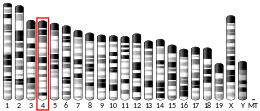NFYC
Nuclear transcription factor Y subunit gamma is a protein that in humans is encoded by the NFYC gene.[5][6][7]
Function
The protein encoded by this gene is one subunit of a trimeric complex, forming a highly conserved transcription factor that binds with high specificity to CCAAT motifs in the promoter regions in a variety of genes. This gene product, subunit C, forms a tight dimer with the B subunit (NFYB), a prerequisite for subunit A (NFYA) association. The resulting trimer binds to DNA with high specificity and affinity. Subunits B and C each contain a histone-like motif. Observation of the histone nature of these subunits is supported by two types of evidence; protein sequence alignments and experiments with mutants. Additional regulation, preliminarily supported by the EST database, may be represented by alternative splicing in this subunit.[7]
Two microRNAs; miR-30c and miR-30e are located within introns of the nfyc gene. These microRNAs are actively transcribed in human insulin-producing beta cells in the pancreatic islets that also show high expression of nfyc and CDH1 genes. The expression of these intronic microRNAs is essential for maintaining the differentiated phenotype of human islet beta cells. Inhibition of miR-30 family microRNAs induces epithelial-mesenchymal transition of human pancreatic islet cells.[8]
References
- GRCh38: Ensembl release 89: ENSG00000066136 - Ensembl, May 2017
- GRCm38: Ensembl release 89: ENSMUSG00000032897 - Ensembl, May 2017
- "Human PubMed Reference:". National Center for Biotechnology Information, U.S. National Library of Medicine.
- "Mouse PubMed Reference:". National Center for Biotechnology Information, U.S. National Library of Medicine.
- Sinha S, Maity SN, Seldin MF, de Crombrugghe B (Feb 1997). "Chromosomal assignment and tissue expression of CBF-C/NFY-C, the third subunit of the mammalian CCAAT-binding factor". Genomics. 37 (2): 260–3. doi:10.1006/geno.1996.0555. PMID 8921405.
- Bellorini M, Zemzoumi K, Farina A, Berthelsen J, Piaggio G, Mantovani R (Aug 1997). "Cloning and expression of human NF-YC". Gene. 193 (1): 119–25. doi:10.1016/S0378-1119(97)00109-1. PMID 9249075.
- "Entrez Gene: NFYC nuclear transcription factor Y, gamma".
- Joglekar MV, Patil D, Joglekar VM, Rao GV, Reddy DN, Mitnala S, Shouche Y, Hardikar AA (September–October 2009). "The miR-30 family microRNAs confer epithelial phenotype to human pancreatic cells". Islets. 1 (2): 137–147. doi:10.4161/isl.1.2.9578. PMID 21099261.
- Taira T, Sawai M, Ikeda M, Tamai K, Iguchi-Ariga SM, Ariga H (August 1999). "Cell cycle-dependent switch of up-and down-regulation of human hsp70 gene expression by interaction between c-Myc and CBF/NF-Y". J. Biol. Chem. 274 (34): 24270–9. doi:10.1074/jbc.274.34.24270. PMID 10446203.
Further reading
- Mantovani R (1999). "The molecular biology of the CCAAT-binding factor NF-Y". Gene. 239 (1): 15–27. doi:10.1016/S0378-1119(99)00368-6. PMID 10571030.
- Martinelli R, Heintz N (1994). "H1TF2A, the large subunit of a heterodimeric, glutamine-rich CCAAT-binding transcription factor involved in histone H1 cell cycle regulation". Mol. Cell. Biol. 14 (12): 8322–32. doi:10.1128/mcb.14.12.8322. PMC 359371. PMID 7969168.
- Nakshatri H, Bhat-Nakshatri P, Currie RA (1997). "Subunit association and DNA binding activity of the heterotrimeric transcription factor NF-Y is regulated by cellular redox". J. Biol. Chem. 271 (46): 28784–91. doi:10.1074/jbc.271.46.28784. PMID 8910521.
- Dmitrenko V, Garifulin O, Kavsan V (1997). "Isolation and sequence analysis of the cDNA encoding subunit C of human CCAAT-binding transcription factor". Gene. 197 (1–2): 161–3. doi:10.1016/S0378-1119(97)00255-2. PMID 9332362.
- Currie RA (1998). "Functional interaction between the DNA binding subunit trimerization domain of NF-Y and the high mobility group protein HMG-I(Y)". J. Biol. Chem. 272 (49): 30880–8. doi:10.1074/jbc.272.49.30880. PMID 9388234.
- Taira T, Sawai M, Ikeda M, Tamai K, Iguchi-Ariga SM, Ariga H (1999). "Cell cycle-dependent switch of up-and down-regulation of human hsp70 gene expression by interaction between c-Myc and CBF/NF-Y". J. Biol. Chem. 274 (34): 24270–9. doi:10.1074/jbc.274.34.24270. PMID 10446203.
- Yoshida H, Okada T, Haze K, Yanagi H, Yura T, Negishi M, Mori K (2001). "Endoplasmic reticulum stress-induced formation of transcription factor complex ERSF including NF-Y (CBF) and activating transcription factors 6alpha and 6beta that activates the mammalian unfolded protein response". Mol. Cell. Biol. 21 (4): 1239–48. doi:10.1128/MCB.21.4.1239-1248.2001. PMC 99577. PMID 11158310.
- Izumi H, Molander C, Penn LZ, Ishisaki A, Kohno K, Funa K (2001). "Mechanism for the transcriptional repression by c-Myc on PDGF beta-receptor". J. Cell Sci. 114 (Pt 8): 1533–44. doi:10.1242/jcs.114.8.1533. PMID 11282029.
- Chen F, Ogawa K, Liu X, Stringfield TM, Chen Y (2002). "Repression of Smad2 and Smad3 transactivating activity by association with a novel splice variant of CCAAT-binding factor C subunit". Biochem. J. 364 (Pt 2): 571–7. doi:10.1042/BJ20011703. PMC 1222603. PMID 12023901.
- Romier C, Cocchiarella F, Mantovani R, Moras D (2003). "The NF-YB/NF-YC structure gives insight into DNA binding and transcription regulation by CCAAT factor NF-Y". J. Biol. Chem. 278 (2): 1336–45. doi:10.1074/jbc.M209635200. PMID 12401788.
- Salsi V, Caretti G, Wasner M, Reinhard W, Haugwitz U, Engeland K, Mantovani R (2003). "Interactions between p300 and multiple NF-Y trimers govern cyclin B2 promoter function". J. Biol. Chem. 278 (9): 6642–50. doi:10.1074/jbc.M210065200. PMID 12482752.
- Hirose T, Sowa Y, Takahashi S, Saito S, Yasuda C, Shindo N, Furuichi K, Sakai T (2003). "p53-independent induction of Gadd45 by histone deacetylase inhibitor: coordinate regulation by transcription factors Oct-1 and NF-Y". Oncogene. 22 (49): 7762–73. doi:10.1038/sj.onc.1207091. PMID 14586402.
- Chattopadhyay C, Hawke D, Kobayashi R, Maity SN (2004). "Human p32, interacts with B subunit of the CCAAT-binding factor, CBF/NF-Y, and inhibits CBF-mediated transcription activation in vitro". Nucleic Acids Res. 32 (12): 3632–41. doi:10.1093/nar/gkh692. PMC 484179. PMID 15243141.
- Wang B, Gao C, Ponder KP (2005). "C/EBPbeta contributes to hepatocyte growth factor-induced replication of rodent hepatocytes". J. Hepatol. 43 (2): 294–302. doi:10.1016/j.jhep.2005.02.029. PMID 15922473.
External links
- NFYC+protein,+human at the U.S. National Library of Medicine Medical Subject Headings (MeSH)
This article incorporates text from the United States National Library of Medicine, which is in the public domain.








